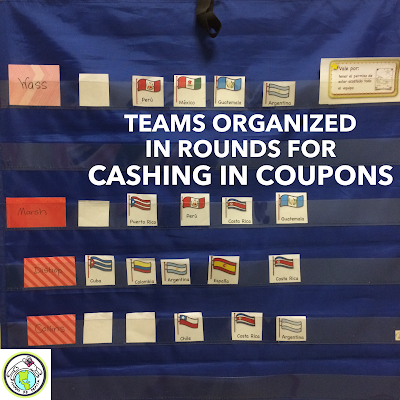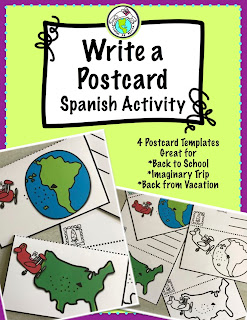NOW, I HAVE TO SAY THAT I AM PHILOSOPHICALLY AGAINST REWARD SYSTEMS, so this was a huge adjustment for me to even contemplate. However, I made the concession in hopes of seeing a positive return- I have now been using this system for three years and I am happy with the results, on the whole (there have been some class/personality dynamics that have challenged the system, but we worked through them). Here is how I set it up:
HOW THE SYSTEM WORKS in essence (please ask clarifying questions for anything that is confusing- it's a little hard to explain everything and not miss something!):
Teams are formed, with each student in the team having a role- captain, mascot, secretary, and trainer. (Captain: keeps the team on track and focused; Mascot: cheers everyone on and keeps things positive; Secretary: organizes the folders, holds onto the coupons in their folder; Trainer: helps whoever needs it- these are rotated at the beginning of every month so everyone has a turn at all the roles) Teams choose a country as their name and receive a flag which serves to identify them. Flags need to be displayed at all times so I know which team to award any points. Students use the word of the week (posted) in a sentence to earn a point for their team. I keep track of the team points on charts, one for each class. For every 5 points earned, the team gets a coupon with a privilege (see below) which they can turn in on their designated day. The team can turn in as many coupons on their day as they choose, or can hoard them and not turn in any. Team members need to work together, helping one another, and being sure that all members are contributing. If I notice that one student is earning all the points, I will "mute" that student until others begin contributing. NOTE ON BEHAVIOR MANAGEMENT: sadly, there have been individuals whose behavior is a great challenge to his/her team and to the class. Rather than the whole team receiving a consequence, I let the class know that the particular individual will not be able to take part in the privilege on the next designated day. Although a bummer, this has been necessary, though very infrequently.
*I LOOK AT THE CLASS LIST and form the teams. I think about who will work well together, and try to mix up the teams so there are a variety of learning strengths and personality types. I also take into consideration friendships, attendance record (there are some kiddos who just don't come to school regularly unfortunately), and past conflicts. Because we have been together for 4 years already, I know them well and can usually put effective teams together.
*I CREATE AND PRINT OUT COUPONS for privileges they can earn (in my class we have tickets for: the whole team holding a stuffed animal, laying down, sitting on cushions, earning an extra point for the team, and a wild card which can be turned in for any of the above privileges). I print out a load of these tickets and keep them in a basket in my room
*I SET UP A POCKET CHART WITH THE HOMEROOM CLASS NAMES in it. This will serve to track designated coupon days. Once students choose their team names, I print out flags for each team and put them in the pocket chart next to the homeroom name. One team gets a turn each class to turn in coupons; when the class arrives, the next flag in order across the chart is the one who has a turn that day. I turn the flag over so we know they've had a turn for that round. Once all five teams have had a turn, I flip all the flags over and we start a new round. When they sit down, they have the responsibility of turning in any coupons within the first 5 minutes; during the first few months I remind them as needed, but by mid year I give them the initial reminder when they enter and if they forget, then they have to wait.
*I FILL OUT THE ROLES FORM FOR THE FIRST MONTH- after September, students fill these forms out, but to get them going (and save time!) I fill out who will be who, captain, mascot, etc for Sept.
FIRST CLASS:
*I ORGANIZE STUDENTS IN THEIR TEAMS and tell them where they will sit.
*I INTRODUCE THE IDEA OF BEING A TEAM using a photo I printed off of Equipo Barcelona- since most of my students are familiar with soccer, and more specifically the Spanish leagues, it's an easy way to convey meaning. I give the class a rough outline of how the system will work and organize them into their teams. I then instruct them to choose three countries that they would like as their team name. After about 2 minutes, I call on each group and ask them what their first preference is, writing it on the board. If there are repeats, I designate a number to each team, put the numbers in a basket and choose one. The team I choose gets first preference; the other team goes to second preference, and so on. I also hand out the roles form at this time. (You could choose any cultural aspect- famous people, foods, capitals, etc- for the team names).
*I SHOW THEM THE SMALL WHITEBOARD I HAVE at the front of class and give them examples of how they can earn a point using a word. So, for example, if the word is 'Tengo' (I have, I am) they could say 'Tengo calor' (I'm hot) or 'Tengo un diente flojo' (I have a loose toothe) or 'Tengo dos gatos' (I have two cats) and so on. By 4th grade, most of my students can utilize pattern sentencing to create short sentences and phrases in the target language. I also emphasize that it has to be a full sentence but it can certainly be silly! NOTE: Regarding grammatical correctness and their sentences- I am not looking for full accuracy for every sentence, but I do encourage and, in some instances, expect a close approximation. If what they attempt is significantly off, I will help them put it together better. And, if it is a sentence structure we've used a lot over the course of the previous four years, I am stricter about getting it "right". (an example: if a kiddo says 'estoy calor' instead of 'tengo calor' I will ask them to look at it again and fix it before awarding a point- we've been using that phrase since September of First Grade)
*WE PRACTICE MAKING SAMPLE SENTENCES so they understand what the expectation is.
AFTER THE FIRST CLASS (prep):
*I PRINT OUT SMALL FLAGS of the countries chosen and glue them to pieces of stiff paper- these are for the teams to put out at the beginning of each class so I can identify them. I remind them at the beginning of every class to take out their flag and put it on the rug in front of their team so I can see it.
*I CREATE SCOREBOARDS for each class with the appropriate flags and post in my room
*I SET UP THE DESIGNATED COUPON 'TURN IN' DAY CHART with flags
*I PUT ONE FREE COUPON in the folder of the secretary for each team so they all have one to start with.
AND THEN WE ARE OFF! It takes my students a few weeks to get used to the system, but once they get a hang of it, they are very successful. I try to choose a variety of words (nouns, adjectives, verbs, country names, culture vocab, etc) over the course of the year; sometimes they are directly related to the theme we are focusing on, sometimes it's a word I want reinforced regardless of theme. We have class twice a week, so students have two opportunities to create sentences with the word. I will say as another classroom management piece, depending on the class and what else we need to get done, I will limit how many sentences are shared out. I don't want to interrupt their enthusiasm and use of the language, but sometimes we need to move on to other content. If they are super excited and we need to get other things accomplished, I encourage them to write the sentences out during recess or lunch and bring them to me later in the day. I award the points accordingly. I would love to hear how you organize teams in your classes!

















